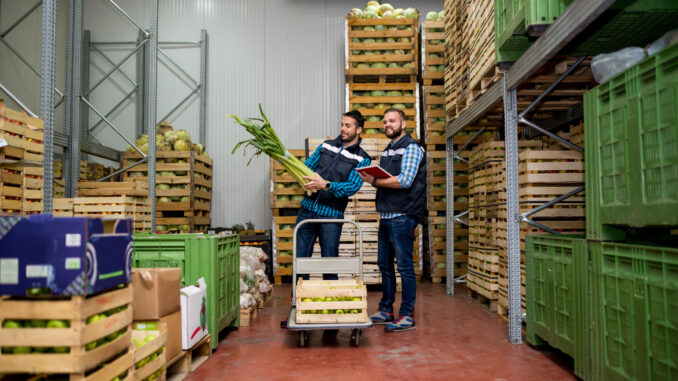
By Francine L. Shaw, Co-founder, My Food Source - 8.1.2023
In an era where consumers prioritize safety, ethical sourcing, and sustainability, restaurant owners and operators are searching for innovative solutions to build a safer, more transparent supply chain. Today’s consumers refuse to take things at face value. They want proof that brands are doing the right things in terms of following best practice safety protocols, working only with responsible vendors, ensuring product authenticity, mitigating risks, and boosting their sustainability practices. When restaurants improve their supply chain transparency, it shows that they have nothing to hide, and they’re committed to following proper business practices (and only working with vendors who are aligned in this commitment).
The advantages of a more transparent, efficient supply chain go far beyond improving consumer trust, though. When restaurants embrace technology to create resilient, flexible, efficient, and safe supply chains, they’ll reap numerous benefits, such as improved risk mitigation, increased productivity, better compliance with regulations, and enhanced ethical sourcing.
Why Restaurants Need a Transparent, Efficient Supply Chain
Restaurant technology has revolutionized supply chain management by promoting transparency and efficiency. When restaurants embrace digital tools and implement effective strategies to establish a safer, more transparent and resilient supply chain, they’ll experience numerous benefits, including:
- Improved Consumer Trust. One of the key advantages of a transparent supply chain is improved consumer trust. Customers who see the ethical origins and safe processes behind a restaurant’s products develop trust and are more likely to support the brand. Moreover, transparency enables businesses to effectively identify and mitigate potential risks, including product recalls, quality control issues, ethical practices, and environmental concerns. This risk mitigation safeguards the reputation of the restaurant and minimizes disruptions. Enhanced trust leads to improved customer loyalty and repeat business.
- Enhanced Risk Mitigation. Transparency across the supply chain enables businesses to effectively identify and mitigate potential risks. With increased visibility, companies can promptly address product recalls, quality control, ethical practices, and environmental concerns. By proactively managing risks, restaurants can maintain their reputation and minimize the impact of potential disruptions.
- Increased Efficiency. A transparent supply chain facilitates better coordination, communication, and collaboration. Leveraging technology such as AI, IoT sensors, and data analytics provides real-time data, automates processes, and enables efficient tracking of products from source to destination. As a result, operations are streamlined, delays are reduced, spending is decreased, and overall efficiency is enhanced.
- Optimized Processes. A transparent supply chain optimizes processes and streamlines operations, allowing restaurants to increase productivity, efficiency, and insights, while reducing disruption, spending, and waste. Digital technologies, such as AI, IoT sensors, and data analytics, provide real-time data, automate processes, and enable more efficient tracking of products from source to destination.
- Better Compliance with Regulations. Many industries, including the restaurant sector, are subject to regulations and compliance requirements. By establishing a safer, more transparent supply chain, restaurants can ensure they operate within legal frameworks. Compliance with regulations is essential for avoiding penalties, maintaining consumer trust, and protecting a brand’s reputation.
- Improved Sustainability. Transparent supply chains support ethical sourcing practices, allowing restaurants to demonstrate their commitment to social and environmental sustainability. Given consumers’ increasing concern about ethical practices, such as fair trade, responsible sourcing, and environmentally friendly processes, restaurants that align with these values are more likely to win customer loyalty and support.
Critical Ways to Build a Safer, More Transparent Supply Chain
Restaurants that want to build and maintain a better supply chain should:
- Leverage Technology. Leverage digital tools such as AI, IoT sensors, and data analytics to enhance visibility and traceability in the supply chain. Real-time data and automation enable efficient tracking of products, ensuring transparency from source to destination. Luckily, technology is becoming much more affordable, accessible, and user-friendly for restaurants of all sizes.
- Boost Collaboration with Supply Chain Partners. Encourage open communication and collaboration with suppliers, manufacturers, distributors, and other partners. Establishing a culture of transparency allows all parties to share information, address issues collectively, and work towards common goals. Collaboration strengthens the supply chain ecosystem and promotes trust among partners.
- Measure and Monitor. Develop clear standards and metrics to measure and monitor supply chain transparency. This includes guidelines for supplier selection, product labeling, responsible sourcing, and sustainable practices. Regularly assess performance against these metrics and make improvements when necessary to ensure continued transparency.
- Train Employees Properly. Educate employees about the importance of supply chain transparency and their role in upholding it. Provide training and resources to help them understand the impact of their actions on the overall supply chain integrity. Engaged and informed employees contribute to a culture of transparency within the organization.
- Communicate with Stakeholders. Maintain open communication with key audiences, including customers, employees, investors, regulatory bodies, and industry organizations. Transparency about supply chain practices, sustainability initiatives, and progress toward goals helps build trust and foster stakeholder support.
The benefits of building and maintaining a safer, more transparent supply chain are numerous and significant. By doing so, restaurants will be able to improve efficiency, safety, sustainability, communication, compliance with industry regulations, as well as consumer trust.
 Francine L. Shaw, food safety specialist, podcaster, and co-founder of My Food Source, is a successful entrepreneur, author, and speaker who spent 20+ years working in the foodservice industry. Her career has included performing services (operating partner, corporate/private trainer, health inspector, 3rd party inspector, adjunct professor) in various sectors of the foodservice industry. She has written hundreds of articles for national trade magazines and appeared on Dr. Oz, the BBC World Series Radio, and iHeart Radio as a food safety expert.
Francine L. Shaw, food safety specialist, podcaster, and co-founder of My Food Source, is a successful entrepreneur, author, and speaker who spent 20+ years working in the foodservice industry. Her career has included performing services (operating partner, corporate/private trainer, health inspector, 3rd party inspector, adjunct professor) in various sectors of the foodservice industry. She has written hundreds of articles for national trade magazines and appeared on Dr. Oz, the BBC World Series Radio, and iHeart Radio as a food safety expert.
Are you an industry thought leader with a point of view on restaurant technology that you would like to share with our readers? If so, we invite you to review our editorial guidelines and submit your article for publishing consideration.

